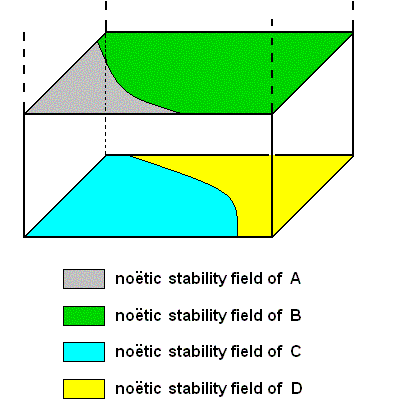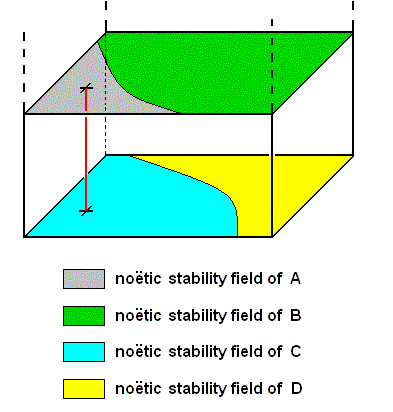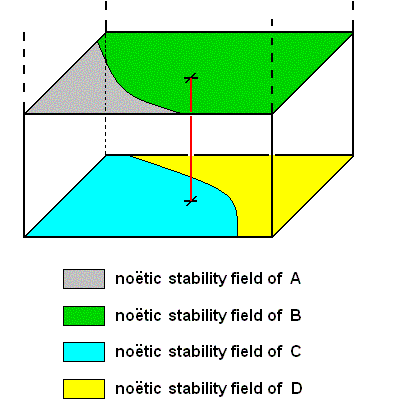

As will be explained later on, the Implicate Order (= Noëtic Order) is partitioned into a vast number of noëtic stability fields. Each such a field represents a particular sub-range in the Implicate Order in which (sub-range) some given noëtic pattern (for example the formal content of a family-groundplan) is noëtically stable, while outside this range it is not, and can, as a consequence, not noëtically exist there.
The Figure above depicts a small section of the noëtic stability landscape of the Implicate Order. The two horizontal dimensions or axes symbolize two noëtic variables (which vary along these dimensions) that determine noëtic conditions (analogous to the two thermodynamic conditions of temperature and pressure). Where in the noëtic stability landscape the two noëtic conditions are such that a given noëtic pattern (such as a groundplan) is noëtically stable, a noëtic stability field of this pattern is defined. And this field can totally or partially overlap with the noëtic stability field of another noëtic pattern (another groundplan), which in the diagram is expressed by placing these totally or partially overlapping stability fields one above the other.
The DIAGRAM shows a part of the stability field of noëtic pattern A (brown). When the noëtic conditions are such that A finds itself in this field it is noëtically stable. The diagram also shows a part of the stability field of noëtic pattern B (green). When the noëtic conditions are such that B finds itself in this field it is noëtically stable.
And in addition to these the diagram depicts the stability field of noëtic pattern C (blue). And again, when the noëtic conditions are such that C finds itself in this field it is noëtically stable.
Finally, the diagram depicts the stability field of noëtic pattern D (yellow). And again, when the noëtic conditions are such that D finds itself in this field it is noëtically stable.
And, as can be seen, the noëtic stability field of A (brown) partly overlaps with that of C (blue). Therefore, in the noëtic area of overlap A and C can noëtically coexist together. Further, the noëtic stability field of B (green) partly overlaps with that of D (yellow). Therefore, in the noëtic area of overlap B and D can noëtically coexist together. See next diagrams.

Figure above : If the two noëtic variables are such as indicated by the position of the red vertical line, then noëtic pattern C can noëtically coexist with noëtic pattern A.

Figure above : If the two noëtic variables are such as indicated by the position of the red vertical line, then noëtic pattern C cannot noëtically coexist with noëtic pattern A.
In all this we must realize that the Implicate Order is not a spatial order, neither is it a temporal order. So all terms used above, such as (stability) "fields", "dimensions", "axes", "vertical", "horizontal", and "landscape", are used metaphorically.
Back to main text where the present text was referred to for the second time